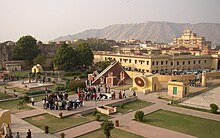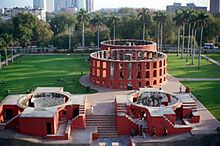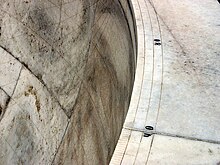Among the devices used for astronomy was Gnomon, known as Sanku, in which the shadow of a vertical rod is applied on a horizontal plane in order to ascertain the cardinal directions, the latitude of the point of observation, and the time of observation. This device finds mention in the works of Varāhamihira, Āryabhata, Bhāskara, Brahmagupta, among others. The Cross-staff, known as Yasti-yantra, was used by the time of Bhaskara II (1114–1185 CE). This device could vary from a simple stick to V-shaped staffs designed specifically for determining angles with the help of a calibrated scale. The clepsydra (Ghatī -yantra) was used in India for astronomical purposes until recent times. Ōhashi (2008) notes that: "Several astronomers also described water-driven instruments such as the model of fighting sheep."
The armillary sphere was used for observation in India since early times, and finds mention in the works of Āryabhata (476 CE).The Goladīpikā—a detailed treatise dealing with globes and the armillary sphere was composed between 1380–1460 CE by Parameśvara. On the subject of the usage of the armillary sphere in India, Ōhashi (2008) writes: "The Indian armillary sphere (gola-yantra) was based on equatorial coordinates, unlike the Greek armillary sphere, which was based on ecliptical coordinates, although the Indian armillary sphere also had an ecliptical hoop. Probably, the celestial coordinates of the junction stars of the lunar mansions were determined by the armillary sphere since the seventh century or so. There was also a celestial globe rotated by flowing water."
An instrument invented by the mathematician and astronomer Bhaskara II (1114–1185 CE) consisted of a rectangular board with a pin and an index arm.This device—called the Phalaka-yantra—was used to determine time from the sun's altitude. The Kapālayantra was a equatorial sundial instrument used to determine the sun’s azimuth. Kartarī-yantra combined two semicircular board instruments to give rise to a 'scissors instrument'.
Introduced from the Islamic world and first finding mention in the works of Mahendra Sūri—the court astronomer of Firuz Shah Tughluq (1309–1388 CE)—the astrolabe was further mentioned by Padmanābha (1423 CE) and Rāmacandra (1428 CE) as its use grew in India.
Invented by Padmanābha, a nocturnal polar rotation instrument consisted of a rectangular board with a slit and a set of pointers with concentric graduated circles.Time and other astronomical quantities could be calculated by adjusting the slit to the directions of α and β Ursa Minor. Ōhashi (2008) further explains that: "Its backside was made as a quadrant with a plumb and an index arm. Thirty parallel lines were drawn inside the quadrant, and trigonometrical calculations were done graphically. After determining the sun’s altitude with the help of the plumb, time was calculated graphically with the help of the index arm."
Ōhashi (2008) reports on the observatories constructed by Jai Singh II of Amber:
| The Mahārāja of Jaipur, Sawai Jai Singh (AD 1688–1743), constructed five astronomical observatories at the beginning of the eighteenth century. The observatory in Mathura is not extant, but those in Delhi, Jaipur, Ujjain, and Banaras are. There are several huge instruments based on Hindu and Islamic astronomy. For example, the samrāt.-yantra (emperor instrument) is a huge sundial which consists of a triangular gnomon wall and a pair of quadrants toward the east and west of the gnomon wall. Time has been graduated on the quadrants. |
The seamless celestial globe invented in Mughal India, specifically Lahore and Kashmir, is considered to be one of the most impressive astronomical instruments and remarkable feats in metallurgy and engineering. All globes before and after this were seamed, and in the 20th century, it was believed by metallurgists to be technically impossible to create a metal globe without any seams, even with modern technology. It was in the 1980s, however, that Emilie Savage-Smith discovered several celestial globes without any seams in Lahore and Kashmir. The earliest was invented in Kashmir by Ali Kashmiri ibn Luqman in 998 AH (1589–90 CE) during Akbar the Great's reign; another was produced in 1070 AH (1659–60 CE) by Muhammad Salih Tahtawi with Arabic and Sanskrit inscriptions; and the last was produced in Lahore by a Hindu metallurgist Lala Balhumal Lahuri in 1842 during Jagatjit Singh Bahadur's reign. 21 such globes were produced, and these remain the only examples of seamless metal globes. These Mughal metallurgists developed the method of lost-wax casting in order to produce these globes.


Jantar Mantar (Jaipur) Yantra Mandir, Delhi.



No comments:
Post a Comment